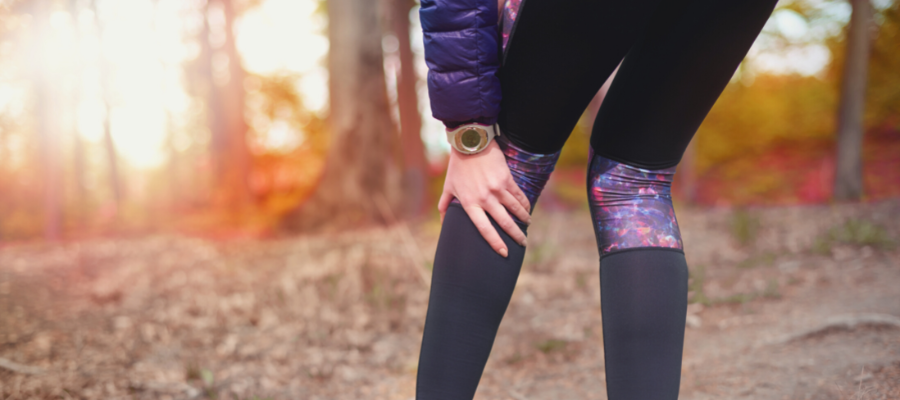|
When did everything start hurting so much? Remember when you could move around without pain? Getting older brings on a certain set of challenges. Aches and pains start happening during simple, everyday activities like walking or climbing stairs. Even just squatting down to pick something up can be tough on the knees as you get older. Knee pain might be common, but it doesn’t have to hold you back. If you know the right exercises to do you might be able to improve it or even prevent it from happening altogether. Strengthening your knees now can keep you active for a very long time. Who says your knees have to age with you? Before we get into prevention that here’s a very quick look at the anatomy of the knee: The knee jointThe knee is a hinge joint, meaning it can flex and extend but not rotate. Well, actually it does rotate somewhat but not to the degree of the hip or shoulder. The bones that make up this joint are the femur (thigh), tibia and Fibula (lower leg). There are 6 main ligaments surrounding the joint: The anterior cruciate ligament (ACL), posterior cruciate ligament (PCL), tibial collateral ligament (inner leg) and the fibular collateral ligament (outer leg). There’s also the posterior cruciate ligament (PCL) and the transverse ligament of the knee in the center of the joint. The muscles that flex the knee are your hamstrings and to extend the knee your quadriceps muscles. The ACL resists excessive extension of the tibia or femur, and the PCL resists excessive flexion of the tibia or femur. This is to help prevent injury. You also have cartilage within your knee: the lateral & medial meniscus as well as the medial and lateral condyle. Cartilage is connective tissue that provides support, cushioning and ensures smooth articulation as you flex and bend your knee. preventionIt’s important to keep the muscles surrounding your knee strong and flexible. Those muscles would be your quadriceps (front of thigh), hamstrings (back of thigh), adductors (inner thigh), abductors (external hip/outer thigh) and even your gastrocnemius (calf muscle). Here are some exercises you can do right at home (and yes, squats are good for your knees when done properly). Exercises and Muscles Worked
Be sure to warm up through rhythmic movements before your exercise and cool down by stretching each muscle worked. If you feel any pain in your knee joint, stop the exercise and consult with a trainer for an alternative exercise. Any pain or exertion you feel should be in the muscle, not the joint. when bad things happen to good kneesThere are a number of different injuries that can happen to your knees along with chronic conditions like arthritis, or even obesity. Being overweight puts a lot more strain on your knees, which could lead to arthritis starting earlier and to a greater degree. Then there are overuse injuries. This is when you perform the same movement too many times without balancing this move with another move that would work the opposing muscles. Remember to work all of the muscles surrounding the knee! For example, if you’re a runner, try adding a couple of bike training into your routine. As for acute injuries such as a torn meniscus or a torn ligament, patellofemoral pain, iliotibial band syndrome you should seek the advice of your doctor. A blog post is not the place to diagnose or treat. repair and recoverySo what do you do if you’ve already injured your knee? Your doctor has given you the ok to exercise, but it’s painful to perform the moves above and you really want to get back in the game. Well, one thing’s for sure: no movement will only make matters worse. Motion is lotion! What I do want to stress here is that everyone is different. Please listen to your doctor on which exercises are and are not right for your particular situation. But here are some general guidelines for you to follow:
other areas to focus onOne of the main reasons you could be having problems with your knees may not be your knees at all. Limited mobility in your hips or ankles can cause your knees to be unstable, forcing them to perform more rotational moves than they were meant to. So be sure to include stretches for your hip and ankles in your routine.
If you have a muscular imbalance (say your quadriceps are much too strong for your hamstrings, or your outer thigh is weaker than your inner thigh), this can throw off the function of your knees as well. Try taking a look in the mirror. Stand barefoot with your feet together. For most people your knees will touch slightly and there will be a space of about an inch between your ankles. If your knees are touching and you have inches between your ankles you are knock-kneed (valgus alignment). If your ankles are touching and your knees are apart you have varus alignment or you’re bowlegged. Some of this could just be the way you are, but it could also be showing you a weakness in one group of muscles. Have a trainer or coach help you determine which exercises would be best for you. Keeping your knees healthy will go a long way in keeping you active as you get into your 50s, 60s and beyond. So be sure to follow a well-balanced resistance program, don’t neglect stretching, and by all means use proper form in and out of the training room. Schedule a free strategy session with me today if you're looking for a little more guidance on finding a program that suits your unique needs. Finding a program that focuses on you as a whole is essential to reaching your goals and keeping you safe in the process. Click here to schedule your free session today!
10 Comments
12/15/2022 11:57:52 am
I am really happy with your blog because your article is very unique and powerful for new readers.
Reply
1/11/2023 07:49:51 pm
I didn't know that lateral lunges worked well for prevention. My knees have been shifting ever since I started wrestling. I'll have to get some knee brace recommendations from a doctor.
Reply
asdfg
1/20/2024 12:50:59 am
Health issues are often a source of fear and stigma, and many leaders avoid them entirely.I am really happy with your blog because your article is very unique and powerful for new readers.https://chromhearts.com/
Reply
ahagf
1/20/2024 12:47:07 am
Thanks For Sharing Information about knee pain and its causes.Exercise is really important to become healthy and to avoid diseases. https://officialovostore.com/
Reply
2/5/2024 08:33:19 am
I thought you made a good point when you mentioned that it is a good idea to seek the advice of a doctor when dealing with a torn meniscus. With that in mind, I would think that it would be a good idea to seek out a sports medicine specialist. I would think that a sports medicine doctor would specialize in this kind of injury.
Reply
4/18/2024 07:34:35 am
Chrome Hearts T-shirts boast premium quality and style, with prices ranging from affordable to luxurious, catering to diverse budgets and tastes.
Reply
4/18/2024 07:36:20 am
Chrome Hearts T-shirts come at a premium price, reflecting their high-quality craftsmanship, unique designs, and coveted brand status among fashion enthusiasts.
Reply
4/18/2024 07:37:34 am
The SP5DER T-shirt combines sleek design with comfort, making it a must-have addition to any wardrobe.
Reply
4/18/2024 07:42:51 am
OVO jackets fuse style and warmth seamlessly, making them a must-have for fashion-forward individuals seeking comfort and versatility.
Reply
Leave a Reply. |
authorLisa Swanson is an ACE Certified Health Coach, Personal Trainer and Orthopedic Exercise Specialist as well as a certified AASDN and PN level 1 nutritionist. With over 35 years experience helping people turn their lives around, she is on a mission to provide relevant and useful knowledge to help women in midlife reach their goals. featured onCheck out my interview with the Magnificent Midlife podcast on staying fit and healthy long-term.
Categories
All
|
What I DoAt Body & Soul Coaching I empower women over 50 to lose weight and feel confident without deprivation diets or spending hours in the gym.
|
Company |
|
|
© COPYRIGHT 2022. ALL RIGHTS RESERVED.
|
Website Design by My Personal Trainer Website
|



 RSS Feed
RSS Feed